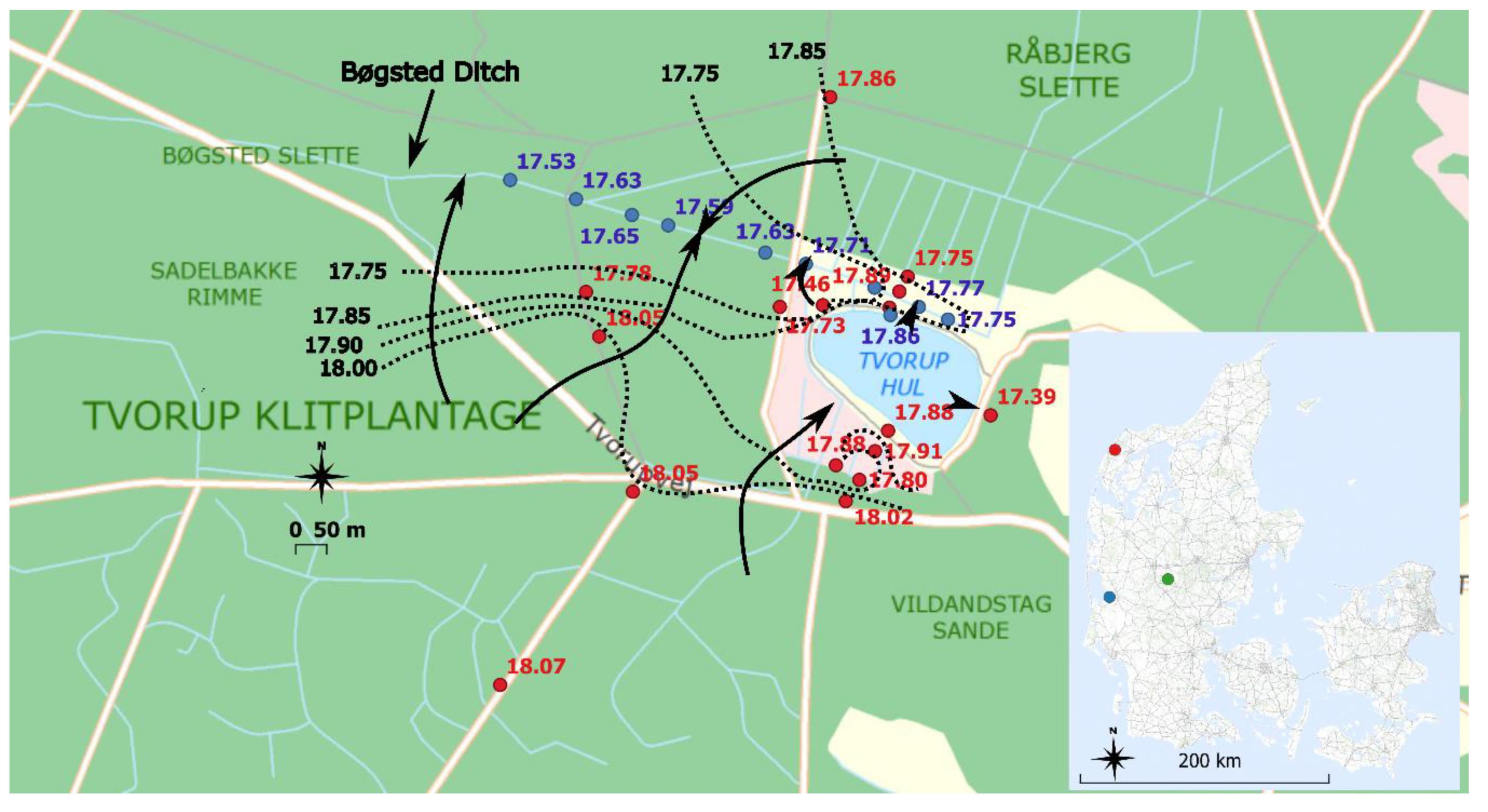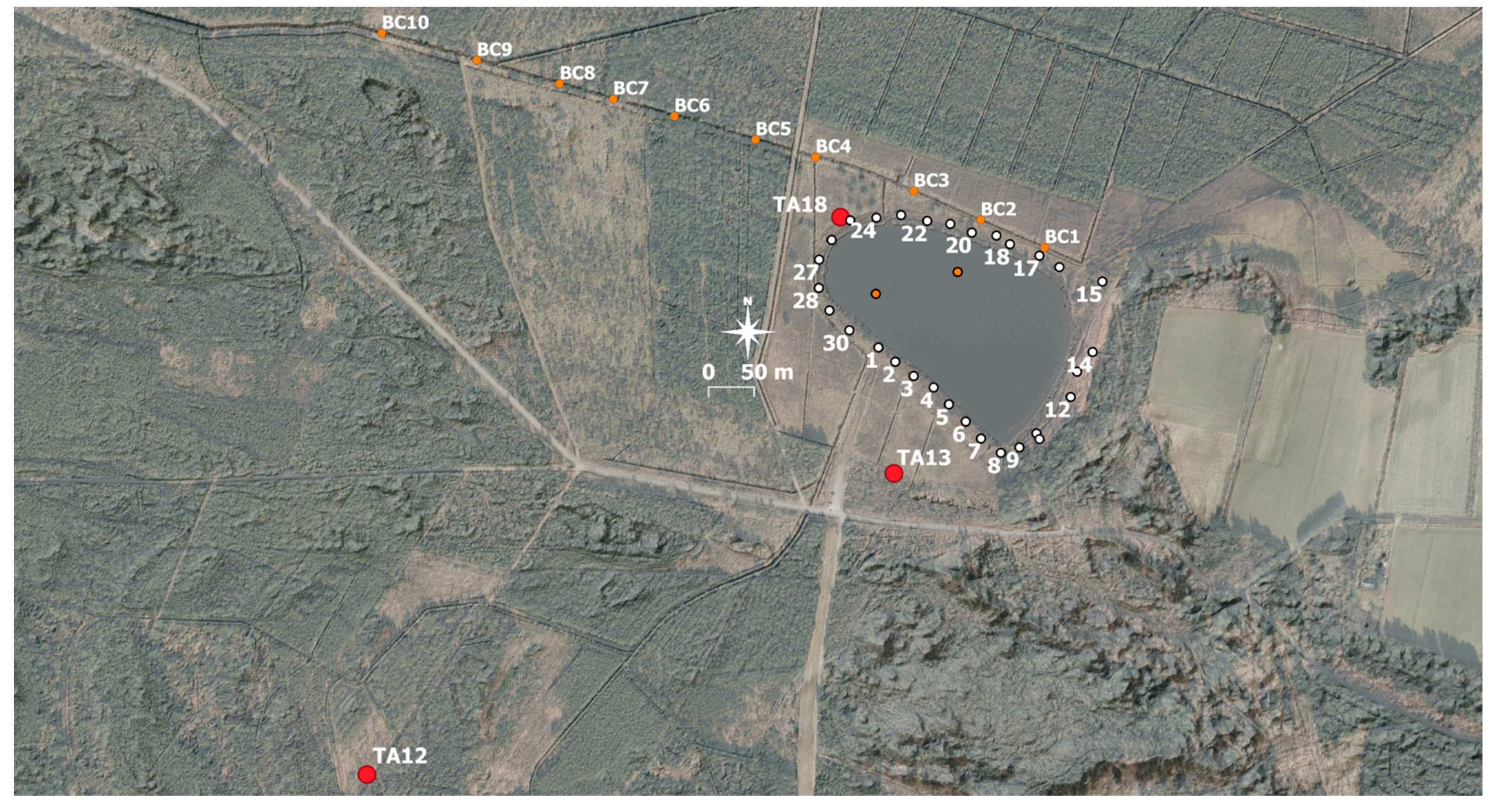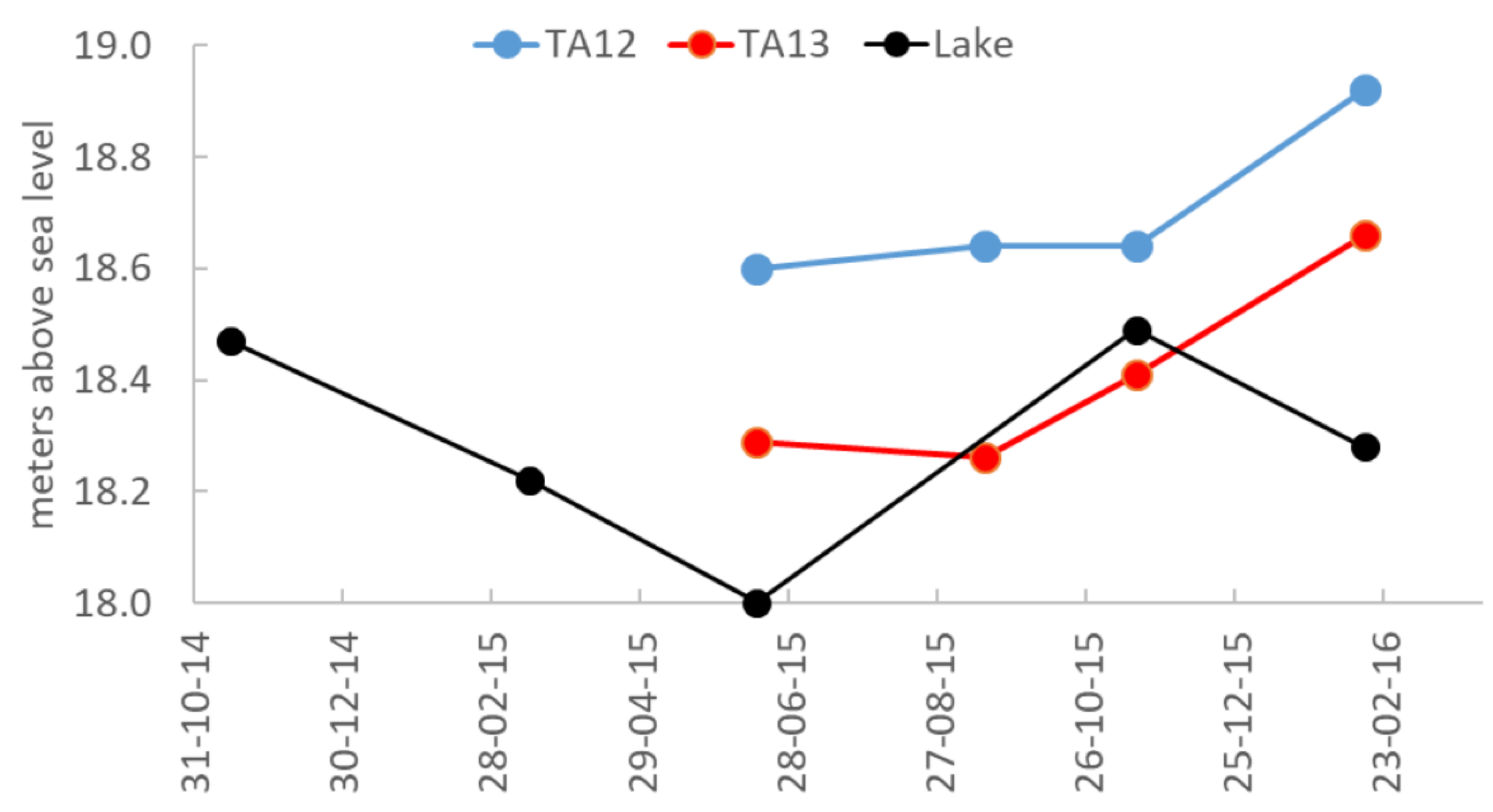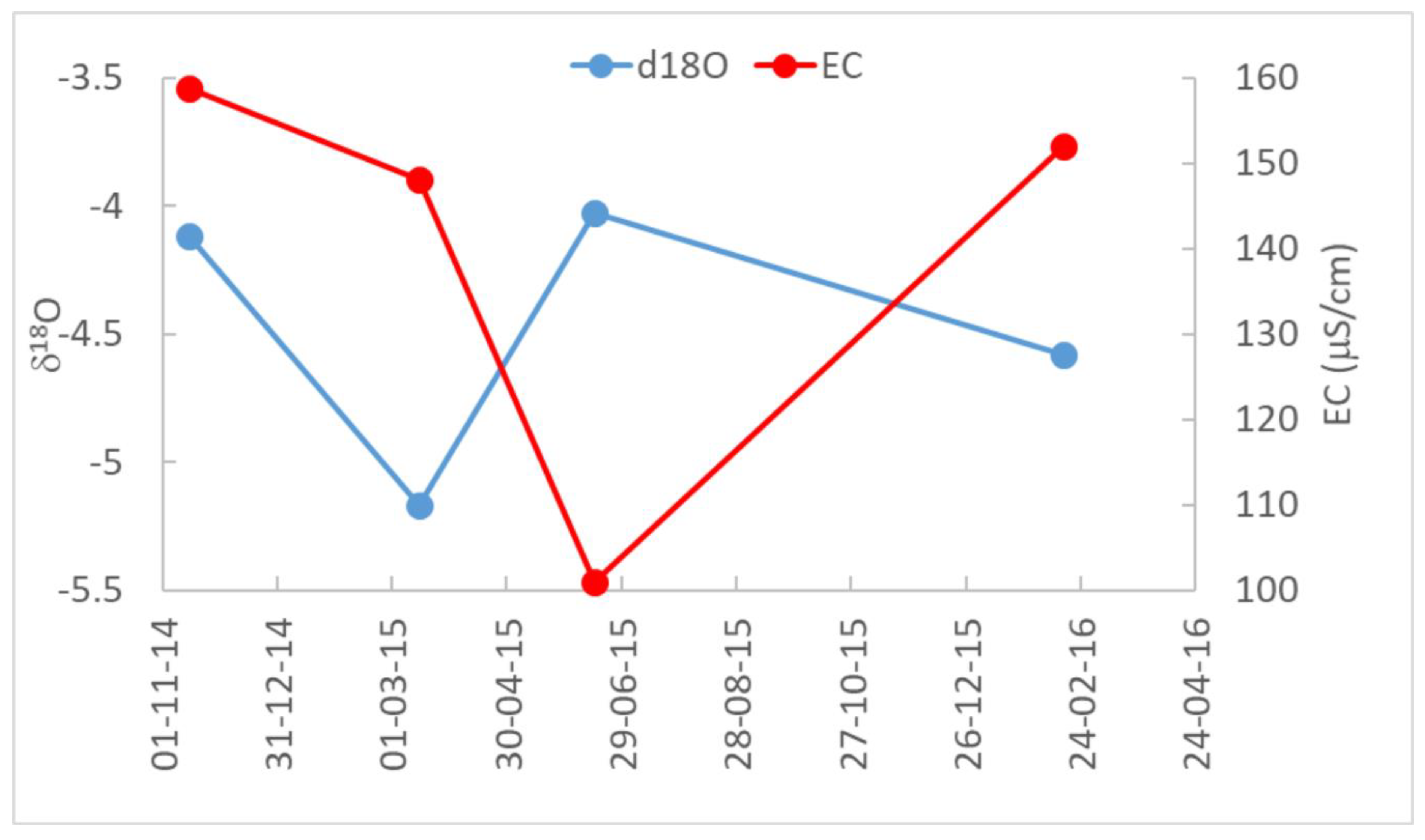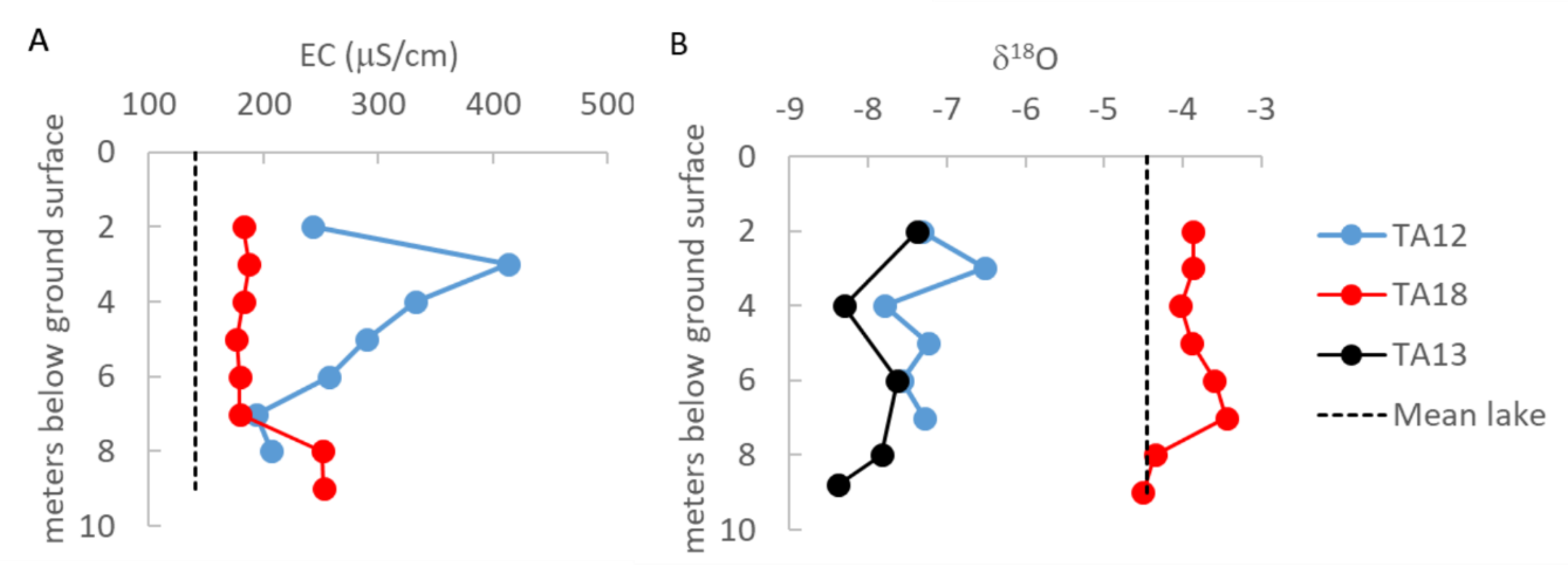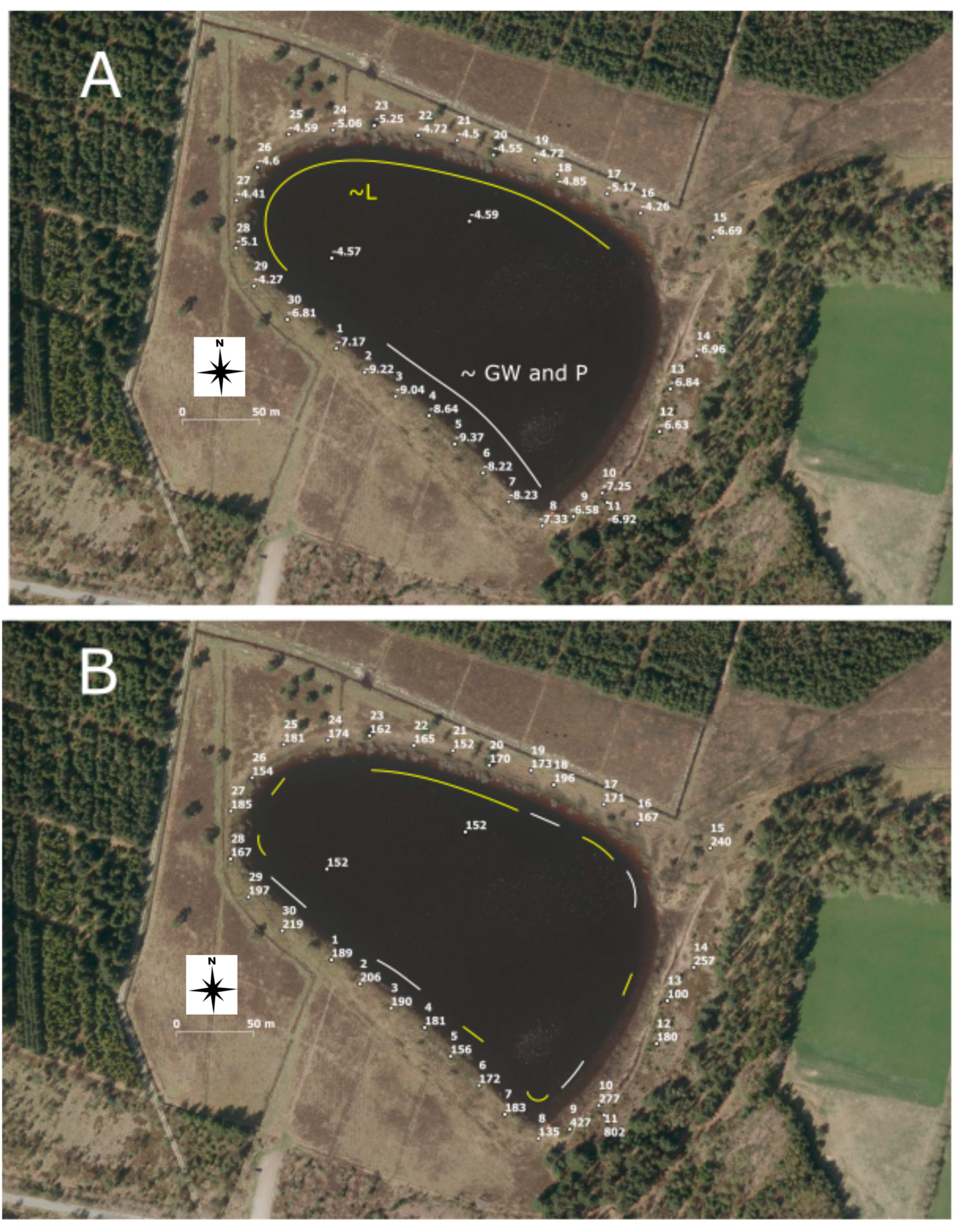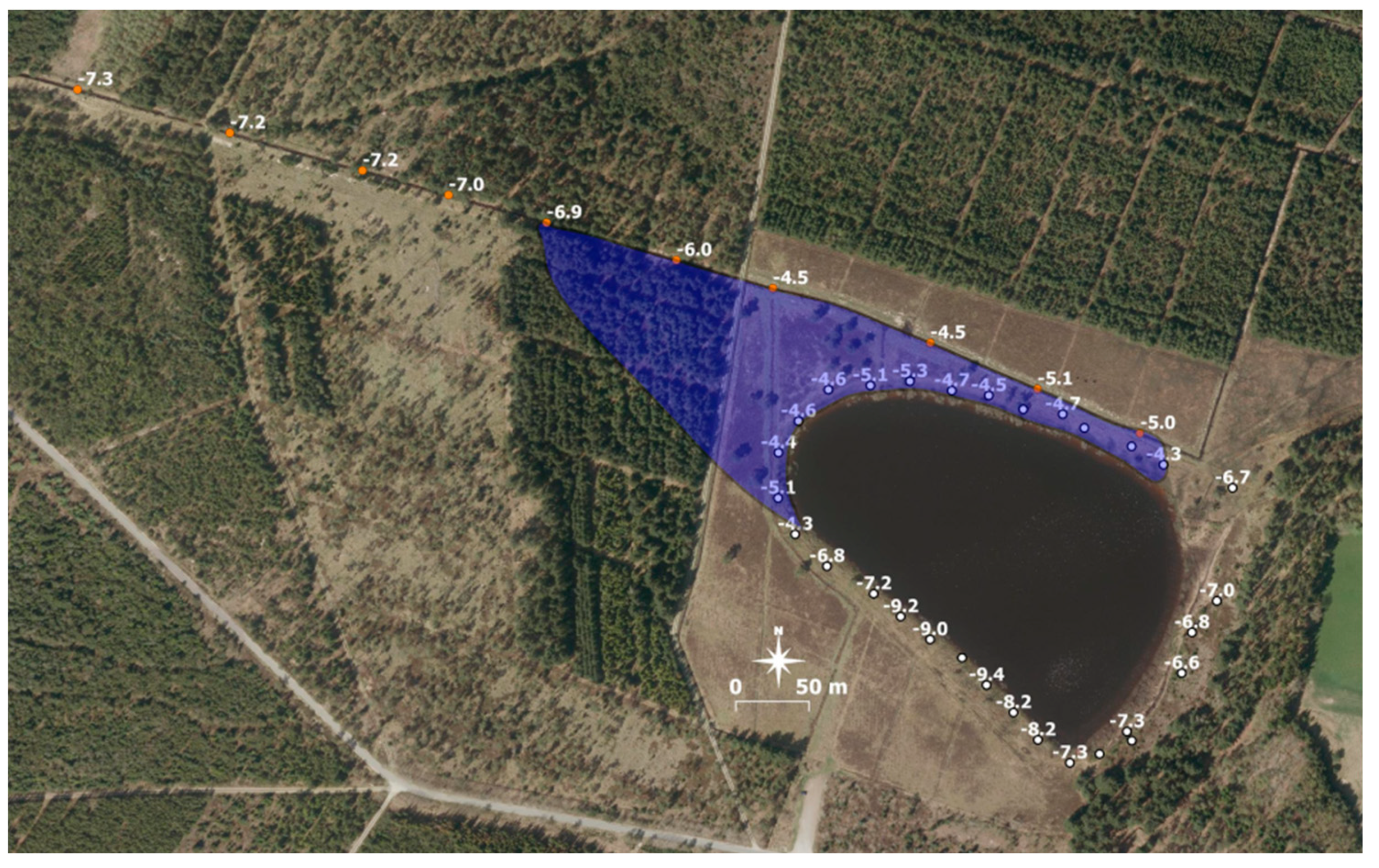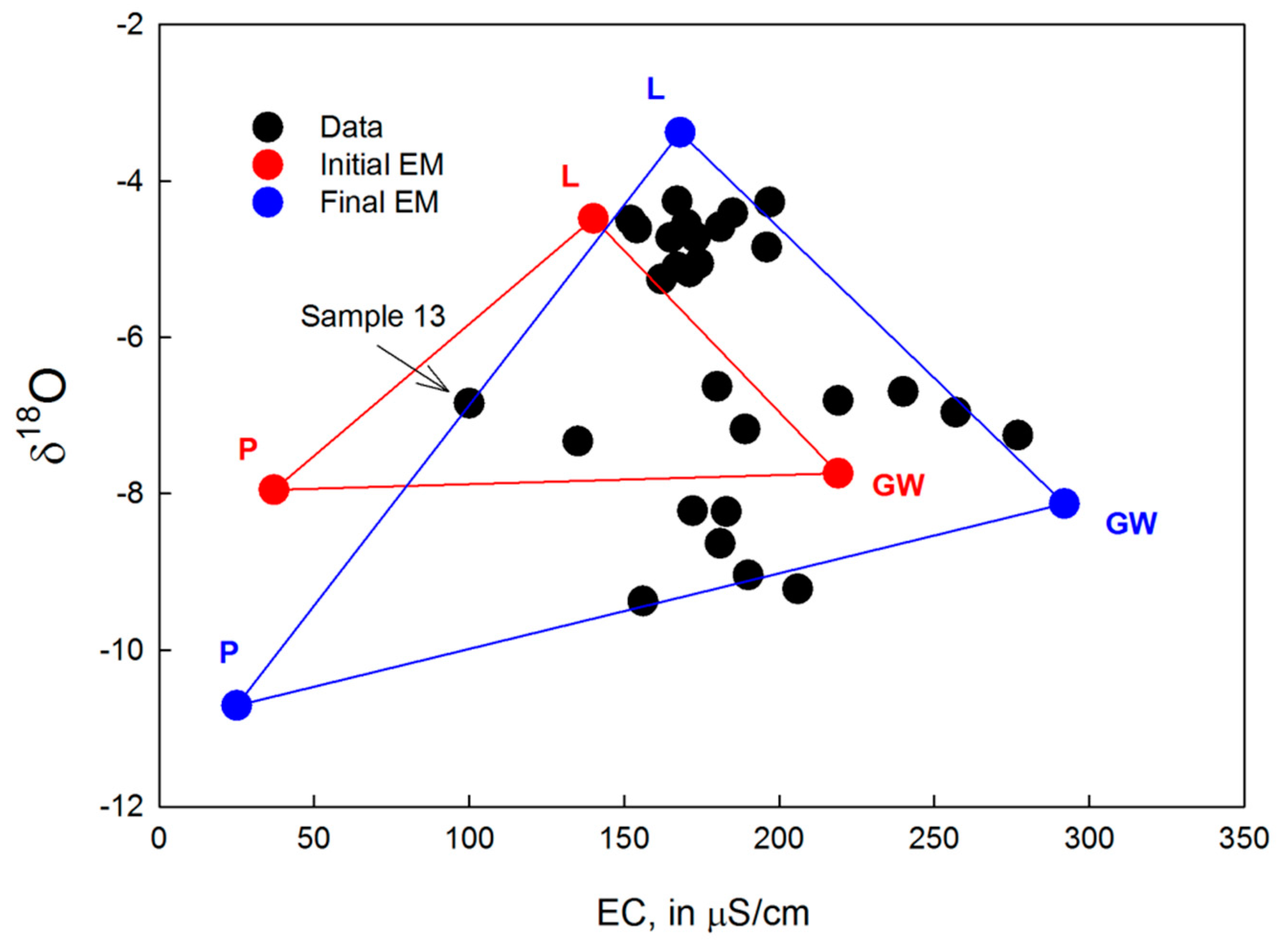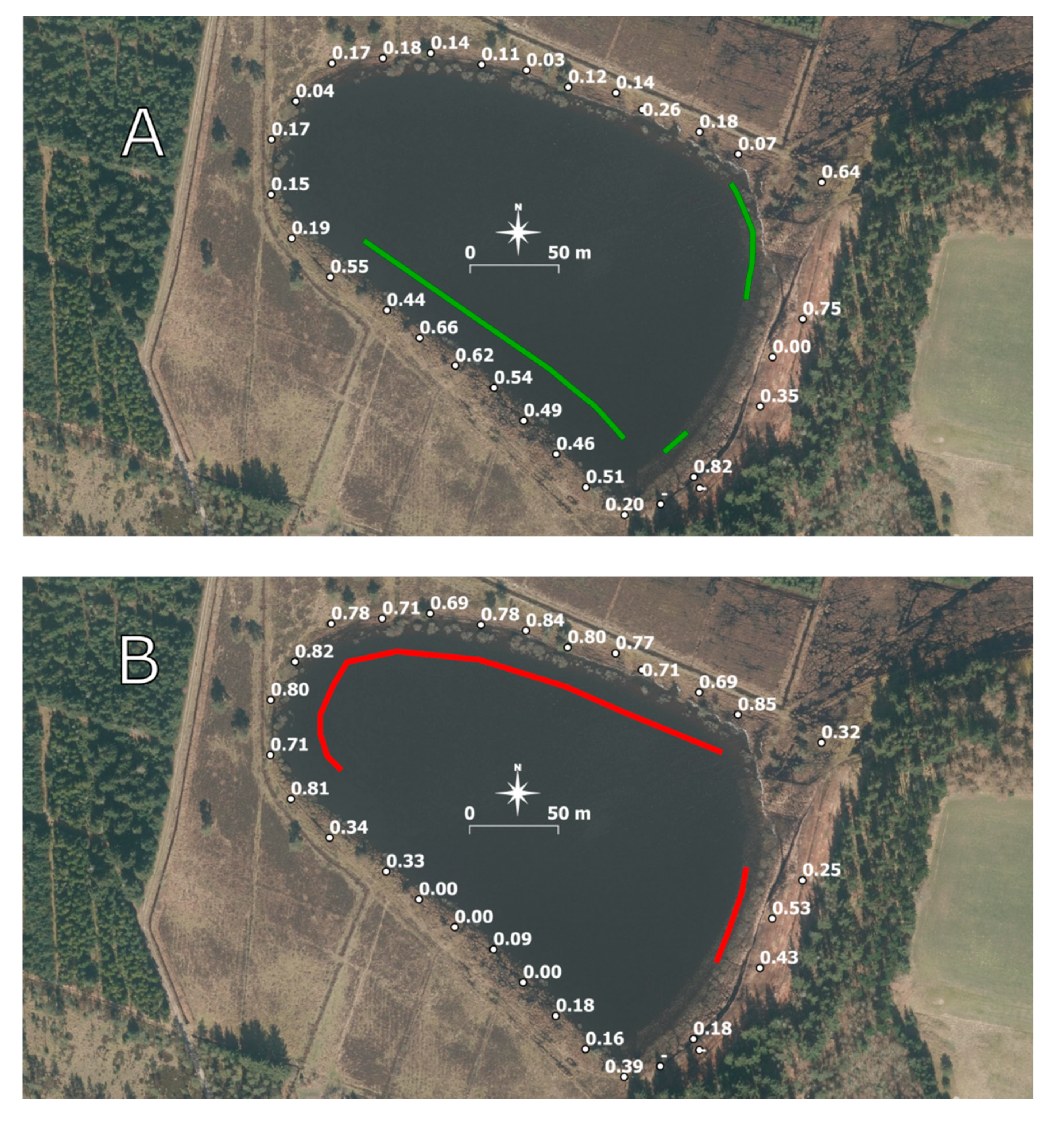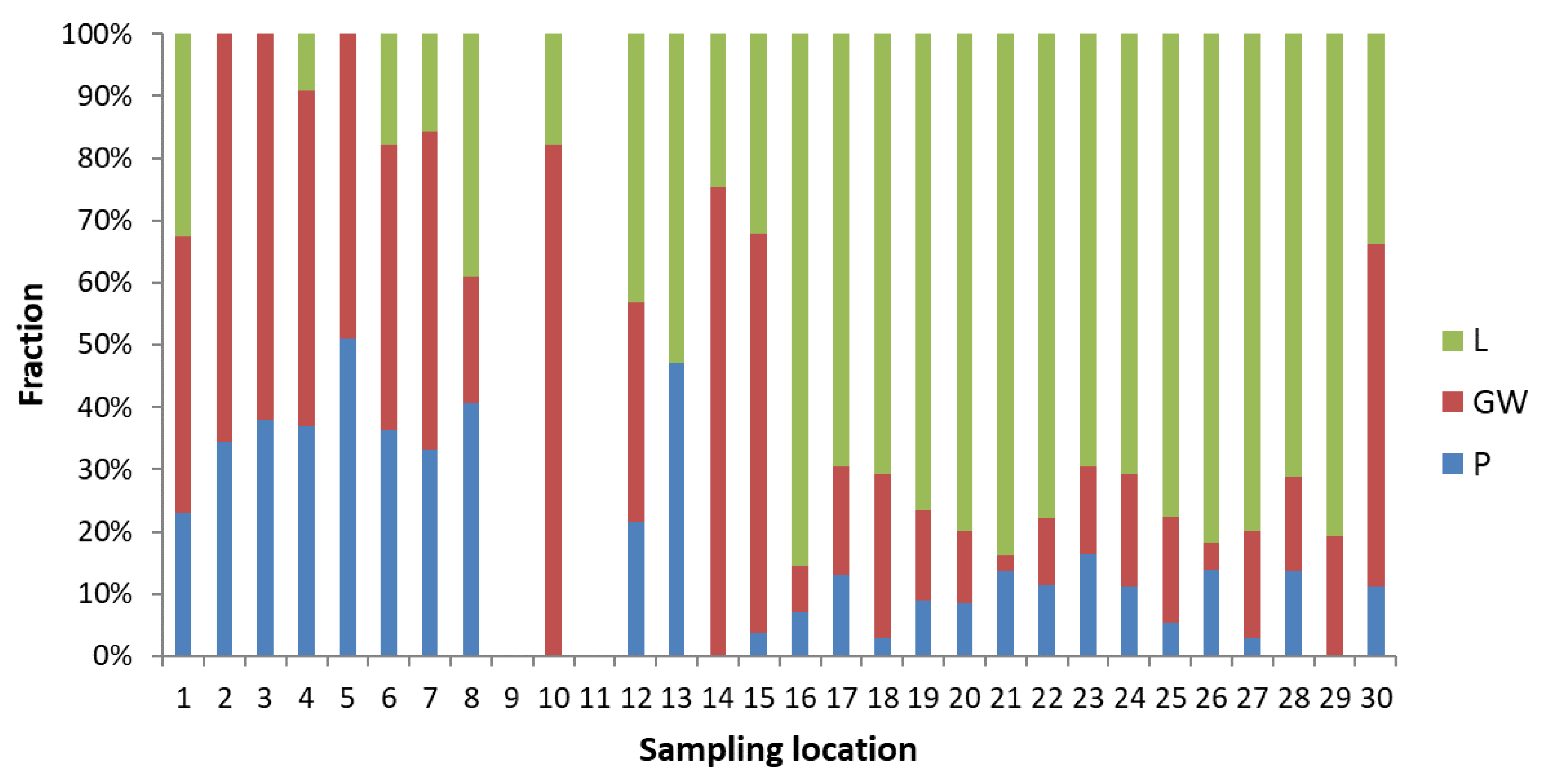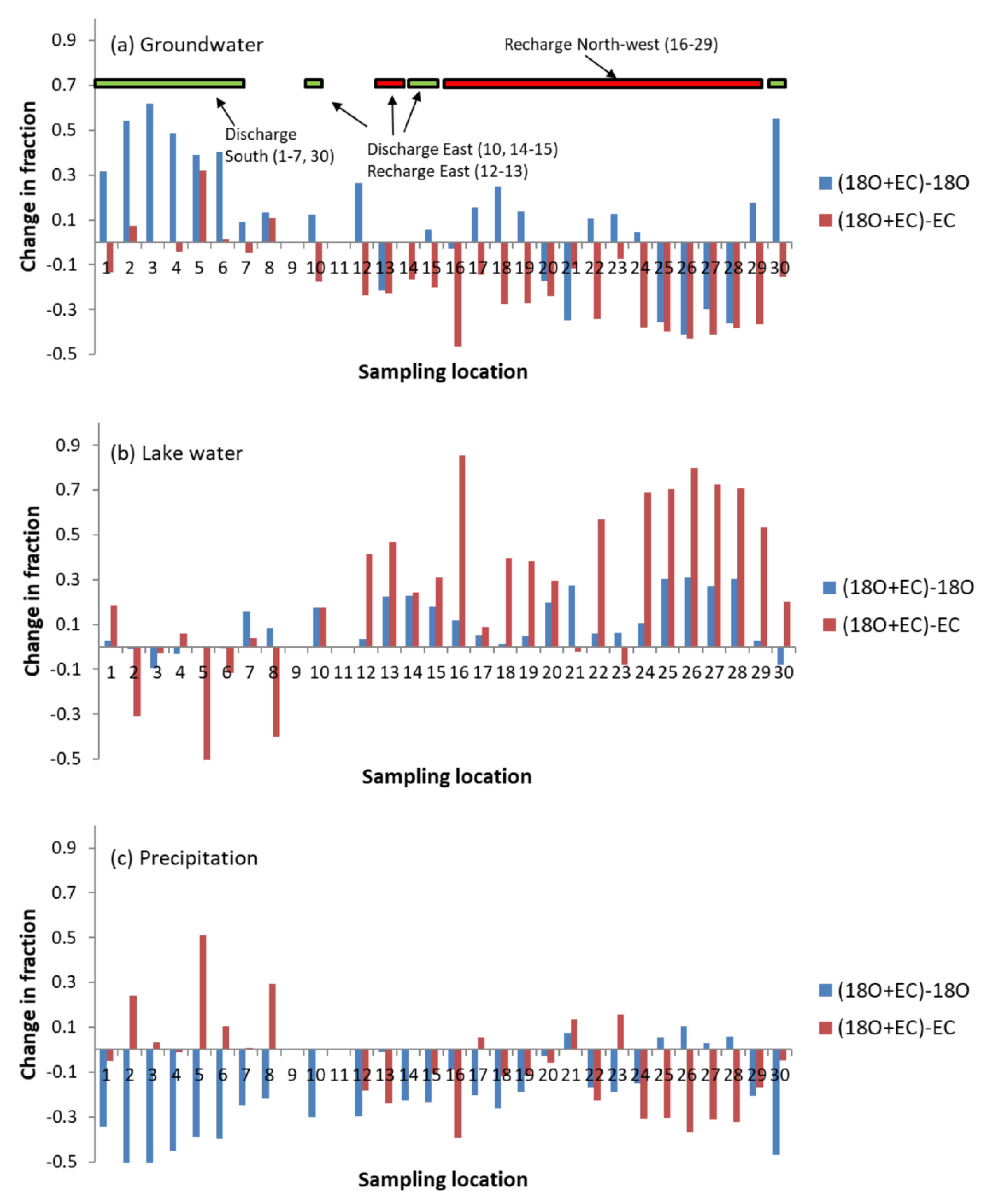1. Introduction
Thy National Park in the northwestern part of Denmark houses numerous small (<1 ha) dune lakes, larger kettle hole lakes, and lakes formed by the dissolution of the high-lying Bryozan limestone [
1]. The lakes are controlled hydrologically by inputs from precipitation, groundwater, or both. The kettle and dissolution lakes are located within coniferous forests planted to control sand drift. The lakes experience brownification via groundwater input of dissolved organic matter (DOM) [
2], which limits light penetration to submerged macrophytes. Management of the forest to both limit input of DOM via groundwater (e.g., by drainage) and, at the same time, securing that enough groundwater still discharges to the lakes is a challenge. Quantification of the spatial input of the invisible groundwater input in relation to forestry and major DOM input at these lakes is therefore essential for keeping good lake water quality.
Estimating the inputs and outputs of groundwater to lakes is a common challenge in hydrological studies. Various field methods for assessing and quantifying groundwater-lake exchange directions and rates have been reviewed earlier [
3]. Among the most popular methods to assess groundwater-lake interaction for small lakes is the flow-net analysis or Darcy approach, which relies on measured hydraulic heads in a network of wells, lake stage, and estimates of hydraulic conductivity. Rudnick et al. [
4], for example, combined hydraulic heads from a well network around two small German lakes with flow balances to estimate net groundwater discharge (positive/negative). If only the direction of the exchange is needed, then only hydraulic heads around the lake and lake stage are required, preferably as time series. The method can be prone to various types of errors. The most common is how accurate one can measure the differential head between groundwater and the lake. In low-gradient systems like those in Thy National Park, this is especially critical, because even a few centimeters of error can mask the true exchange direction. Labaugh et al. [
5] found that it was critical to have wells close enough to the lake to correctly estimate the flow of lake water to groundwater (recharge). Wells located further away from the lake did not capture transpiration-driven lowering of the water table near the lakeshore; hence underestimating outflow from the lake. Many other methods exist and have been used extensively at other Danish lakes (e.g., the temperature-based method [
6,
7], water balance method [
8]), often done in combination with groundwater modeling [
7,
9,
10,
11].
Water stable isotopes (δ
18O) have been used to assess groundwater-lake interactions [
3], typically only for a part of a lakeshore, a lakebed, or with an isotope mass balance for the whole lake, but often not for the spatial distribution of the exchange pattern around the whole lake (whole-lake exchange). The method is becoming increasingly popular due to the conservative properties of water stable isotopes, ease of sampling, and now, relatively easy and in-expensive analysis. Krabbenhoft et al. [
12] investigated discharge–recharge patterns on the eastern shoreline of a small lake in Wisconsin, USA, which confirmed the interpreted flow field based on hydraulic heads and lake stage. Furthermore, they were able to derive a stable isotope mass balance to come up with rates of exchange. Petermann et al. [
13] used a similar approach with the groundwater end-member based on information from a single groundwater well in the catchment. Rautio and Korkka-Niemi [
14] used δ
18O in a watershed study of groundwater and river exchange with a large lake in Finland. The groundwater sampling focused on the eastern shoreline in deeper wells and a few mini-piezometers in the lakebed. Kidmose et al. [
15,
16] assessed groundwater-lake exchanges at two Danish lakes: Lake Hampen, where discharge was observed at two sites and recharge at one site, and Lake Væng, where sampling of the lake bed δ
18O revealed only groundwater discharge. Wollschläger et al. [
17] sampled time series (three years) of δ
18O in the lake water column and deep-screened wells around a small German lake surrounded by gravel pits. In combination with two snapshots of δ
18O in shallow groundwater around the lake, they were able to infer groundwater-lake exchange patterns. Karan et al. [
9] and Schuster et al. [
18] are examples where lakebed profiles of δ
18O were used to assess the direction of groundwater-lake exchange and estimate flux rates at a few points in the lakes. Hajati et al. [
11] and Krabbenhoft and Webster [
19] used the time series of δ
18O in groundwater and lakebed at specific locations to investigate flow reversals (i.e., where the direction of exchange between the lake and groundwater changed directions due to seasonal changes in climate).
The use of end-member mixing analysis in connection with use of δ
18O is not common. Rautio and Korkka-Niemi [
14], and Schuster et al. [
18] used a δ
18O binary (groundwater and lake water) mixing model to compute lake or groundwater fractions in water sampled from lakebeds. In both studies, the end-member δ
18O concentrations were assumed to be known. The use of mixing analysis with uncertain end-members Carrera et al. [
20] offers the advantage that end-member concentrations are computed as part of the solution based on initial estimates and an assigned uncertainty. End-member concentrations are never known precisely due to spatio–temporal changes. Müller et al. [
21] used δ
18O and EC (electrical conductivity) to derive mixing fractions between salt and freshwater in a groundwater-lagoon aquifer. The highest uncertainty was assigned to EC because lagoon salinity was controlled by the operation of a sluice connecting the lagoon to the sea. Transience in hydrology can be detected with a mixing analysis provided there are time series or snapshots of tracer distributions. Jorgensen et al. [
22] used a ternary end-member mixing analysis using
87Sr/
86Sr and EC to investigate the temporal development of a forced salt water intrusion and extrusion experiment.
The main objectives of this study were as follows. (1) to trace the spatial distribution of whole-lake groundwater-lake exchanges at a small groundwater-controlled lake in Thy National Park, Denmark using δ18O and electrical conductivity (EC) as tracers with a simple and innovative sampling system. Whole-lake exchange is defined here as tracing the exchange along the whole lakeshore. (2) To use uncertain end-member ternary mixing analysis to calculate the composition of subsurface water near the lake bed, evaluate the usefulness of the semi-conservative EC tracer, and use this information to further understand whole-lake exchange and explain how transience in hydrology (precipitation, lake stages, flooding) may have affected subsurface water.
2. Field Site
The lake is located within Tvorup Dune Plantation in Thy National Park located along the western coast of Denmark (
Figure 1). Lake Tvorup Hul (UTM zone 32, 467420E, 6314252N) is a small lake with an area of 4 ha, a mean depth of 2.4 m, and a maximum depth of 5 m [
2]. The lake has no in- or outlets and the water received by the lake originates from precipitation and groundwater. The water residence time (WRT) was estimated to a maximum of two years [
2]. The lake is a sinkhole due to dissolution of the high-lying limestone in the area [
1]. The area near the lake is flat and at high lake stages, the lake can flood, especially the southern part of the area. A large ditch (Bøgsted) north of the lake is a drainage ditch dewatering the northern area in order to manage the pine tree plantation. The ditch transports water from east to west (
Figure 1).
The geology is composed of Aeolian and Marine sand deposits near the surface, underneath is a 2–6 m thick clay layer followed by Bryozoan limestone. The layers slope from east to west; to the east, the sand is roughly 1 m thick with limestone seven meters below surface (mbs). To the west, the sand is roughly 8 m thick. The lake, being on average 2.5 m deep, is therefore in full contact with the top layer of sand, but less near the eastern shoreline due to the thinner sand layer. It is uncertain if the clay layer between the sand and limestone is continuous. There may be areas where there is a hydraulic connection between the sand and limestone and therefore between the limestone and the lake. Soil maps reveal a top layer of sand except at the area east of the lake, described as moraine clay.
Land use is mainly pine tree plantation with drainage by small ditches (especially north of the lake). A flat heath area is located south of the lake. This area is occasionally flooded when the lake stage is high. A ditch running from south of the lake, passing the western side of the lake drains groundwater in the heath area and leads it north of the lake to the Bøgsted Ditch. Drainage was primarily developed to better manage the plantation, and in recent years to divert groundwater with high DOM away from the lake and to Bøgsted Ditch.
5. Discussion
Lake Tvorup Hul is located in a groundwater system with low hydraulic gradients. To use measured hydraulic heads from a few wells to assess the interaction between groundwater and the lake can therefore be challenging, because small measurement errors, or short-term transience in the heads and lake stage, can mask the interpretation.
Tracers can be a valuable alternative that, with a minimum of effort, can give a clear representation of groundwater–lake interactions. Tracers reflect longer-term flow processes and are thus less affected by short-term changes in precipitation. δ
18O is especially useful; it is easy to sample and analyze, and has distinct and relatively constant concentrations in deeper groundwater and lake water relative to precipitation. The seasonality of δ
18O in precipitation is damped in groundwater (due to mixing) and in the lake (due to fractionation). The δ
18O concentrations in shallow groundwater around the lake (
Figure 6A) make it relatively easy to define the discharge and recharge zones for the whole lake. Other studies have obtained the same type of results, but typically only for parts of a lake [
12,
14,
15]. The research by Kidmose et al. and Wollschläger et al. [
16,
17] are examples of whole-lake δ
18O studies, but using a much lower sampling intensity. EC is easy and frequently measured in the field, but is not as straightforward to use, which is partly because it is a semi-conservative tracer. Biogeochemical processes in soils, groundwater, and the lake may affect EC. However, it was possible to identify lake segments with the recharge of groundwater along the northern shoreline (
Figure 6B). EC increased only slightly (from around 150–160 μS/cm in the lake to 152–171 μS/cm) with flow of the tracer from the lake and to the sampling locations in recharge segments a few meters away. For both tracers, recharge of groundwater from the lake was best identified because of the distinct lake δ
18O and EC signals (
Figure 8).
The end-member mixing analysis is a quantitative approach and assigns mixing fractions to a sample. In our case, we chose three main end-members: precipitation, groundwater, and lake water. This required information on end-member concentrations and, if using the MIX code, an estimate of the uncertainty of end-member concentrations. The mixing analysis for the dual tracer approach is in good agreement with the qualitative interpretation from the δ
18O samples and the interpreted groundwater flow. The mixing analysis can give additional insights into temporal changes in groundwater–lake interactions in a low-relief area like that surrounding Lake Tvorup Hul. For example, high groundwater fractions along the southern shoreline, relatively high fractions of precipitation, and samples with fractions of lake water (0.1–0.15) were calculated along a continuous segment (locations 30 and 1–7,
Figure 10). In extreme cases, the lake stage can increase by up to 0.5 m (
Figure 3). Lake water in these samples could be due to flooding of the area south of the lake. Depending on the duration of the flooding, lake water may infiltrate to the shallow groundwater and mix with groundwater and precipitation. We interpreted the co-existence of high fractions of groundwater and precipitation at the southern shoreline (
Figure 10) as deeper groundwater flowing upwards toward the lake shore and mixing with vertically downward infiltrating precipitation. The final end-member δ
18O precipitation concentrations were more depleted in cases when EC/δ
18O or δ
18O alone were used in the mixing analysis (
Table 2,
Figure 8). All samples were collected at a depth of 1.25 m below surface in February 2016 (essentially the same as the depth below the water table). Recharge estimate in this region is 0.5 m/year, and with a porosity of 0.3, this gives a vertical downward pore water velocity of 1.5 m/year. In other words, the fraction of precipitation in samples 30 and 1–7 could be a winter slug of precipitation from a year before sampling. The precipitation data (collected off-site) showed many examples of δ
18O concentrations around −10‰ in the winter months, so it is reasonable to assume that similar depleted values were present in local precipitation. The greatest uncertainty in any end-member concentrations was in δ
18O in precipitation. The off-site data may therefore not accurately predict the initial local end-member concentration, but the observed off-site seasonal variability can be used to estimate the end-member concentration more precisely at the time of sampling. The reason we do not see the same fraction of precipitation on the recharge side of the lake could be due to the much smaller infiltration area between the lake and Bøgsted Ditch. If we had attempted to use a binary end-member mixing analysis with groundwater and lake water (excluding precipitation), then we would expect the estimated end-member concentration of groundwater to be much more depleted compared to the average composition of precipitation. We would then have arrived at the same conclusion, that a sample on the discharge side was a mixture of older and younger groundwater, but without the possibility of estimating the two fractions. Otherwise, we would not have been able to fit the depleted values along the discharge segment of the lake.
The final lake δ18O end-member was more enriched than what was originally estimated. This may be explained by one outlier in the lake data with a less enriched value of −5.17‰ (1 March 2015), which greatly influenced the initial choice of end-member concentration. If this measurement had been excluded, the initial value would have been more enriched and closer to the final end-member concentration.
EC end-member concentration in groundwater increased by 25%. We cannot rule out that this change is because EC is not a fully conservative tracer. What was more surprising was that EC in precipitation was further decreased compared to the data from the inland station. One would expect a higher end-member concentration due to the proximity of the lake to the ocean. This was due to sample 13 (from the eastern shoreline,
Figure 8) with an EC of 100 μS/cm lying exactly on the mixing line between precipitation and lake water. Neighboring samples 12 and 14 had approximately the same δ
18O concentrations, but much higher EC concentrations closer to that of groundwater (180–257 μS/cm). If sample 13 had been excluded from the analysis, then the EC in precipitation could have been higher.
These uncertainties also had an implication when using δ
18O or EC alone as a tracer in the end-member mixing analysis. Using δ
18O concentrations alone could not distinguish between precipitation and groundwater discharging along the southern shoreline. This is likely a result of the initial end-member concentrations of groundwater and precipitation, being almost identical (
Table 2). In fact, precipitation was the major fraction along this segment of the lake (
Figure 11a,c). Adding EC helped the mixing analysis because of the distinct difference between groundwater and precipitation (
Table 2). Along the same line, both tracers were able to estimate the fractions on the northwestern lake segment because of the similarity in lake water and groundwater composition.
The effort of collecting these data amounted to roughly two days of field work for a small lake like Tvorup Hul. The ease with which the field work was carried out was partly due to the sandy material in the top making installation of mini-piezometers, clean pumping, and sampling swift. EC was measured in situ so already during field work, one can get an indication of the directions of the exchange of water between groundwater and the lake. This can guide the choice of spacing between sampling locations. The interpretation of groundwater–lake interactions is then readily carried out, which for Lake Tvorup Hul resulted in zones of groundwater discharge from the south, and recharge to groundwater to the north (and then the ditch) and west. At the eastern lakeshore, results were not conclusive, showing both discharge and recharge. There are several reasons for this. First, the lake is not hydraulically well connected to the sand layer, the layer being only ~1 m thick with clay below. Second, we had a well a few hundred meters to the northeast of the lake, screened in limestone at 4.6 mbgs. The well was destroyed by forest machinery, but a few head measurements in the fall of 2015 gave values of 14.2 m, significantly below the lake stage, thus indicating outflow or recharge. Third, it can be seen from
Figure 2 that a small ridge appear just east of the lake, so it is possible that a small groundwater divide could form just east of the lake with occasional discharge to the lake.
Tracers and mixing analysis can be helpful as a first-step in guiding how to establish a monitoring network for better understanding dynamic groundwater–lake interactions. The use of end-member mixing analysis proved valuable in understanding the ternary mixing of precipitation, groundwater, and lake water around the lake and how seasonality in lake stage, flooding, and slugs of precipitation infiltrating the soils may have influenced mixing fractions. This requires knowledge of end-member concentrations, which may not always be available at the desired precision. The MIX code can partly deal with this by allowing for uncertain end-members. Local (lake and groundwater in this case) and off-site (precipitation) information was here used to assess uncertainty, but still, the results were consistent with the rest of the observations done in the field site, indicating that this methodology could be easily exported to study groundwater–lake interactions in other regions with different access to data.
6. Conclusions
This study used δ18O and electrical conductivity (EC) to trace the spatial distribution of whole-lake groundwater-lake exchange and ternary uncertain end-member mixing analysis to quantify the composition of water discharging to or recharging from the lake. The study was carried out at a small groundwater-fed lake with low relief and low hydraulic gradients.
Use of both tracers could accurately depict the spatial pattern of exchange with discharge along the southern lakeshore and recharge along the western and northwestern lakeshore. Exchange along the eastern lakeshore was more uncertain, likely due to poor contact with the sandy aquifer. The tracer results were in good agreement with the interpreted groundwater flow based on hydraulic head data and lake stage.
Use of one tracer alone did not show the same clear exchange pattern along the whole lakeshore. Recharge was still predicted in the same locations, which was caused by a clear enriched signal in δ18O and low EC values in lake water. Where discharge occurred was not as clear, because δ18O in groundwater and precipitation were quite similar in this area. Although EC is a semi-conservative tracer, it proved helpful to assess where the groundwater was discharging, because of the clear difference in EC of the three end-members: groundwater, lake water, and precipitation.
The combination of using several tracers and uncertain end-member mixing analysis is a powerful diagnostic tool in the early phases of an investigation of groundwater–lake interactions. The ternary mixing analysis with uncertain end-members corroborated the qualitative interpretation based on the tracers alone and provided new insights about how transience in hydrology (precipitation, changes in lake stages flooding of an area next to the lake) affected the composition of water discharging to the lake or recharged from the lake. An outcome of the mixing analysis is new estimated end-member concentrations. This was especially useful on the discharge side of the lake, where the use of the two tracers estimated that the water was mainly a mixture of precipitation (~1 year old) and deep groundwater, and less so of lake water (from occasional flooding at high lake stages). This study also demonstrates that the use of off-site precipitation end-member information to predict local conditions is possible. It is important, though, that the off-site data represent the uncertainty in end-member concentrations (seasonality, variance).
